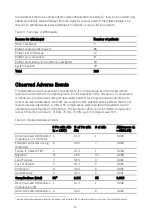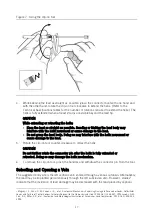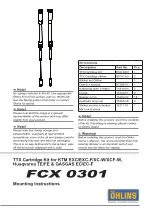
24
interaction. For example, minimize the potential for leads lying on top of each
other under the pulse generator and ensure that there are no sharp bends in
the lead. Lead insulation damage can result in electrical current arcing to the
pulse generator, thereby damaging the high-voltage circuitry, or creating an
alternate electrical current path which may result in compromised therapy
delivery. Current practice indicates that a subcutaneous pocket is preferred
over a subpectoral pocket.
Refer to the appropriate pulse generator manual for the configuration of the ports on each model
and for the use of setscrews, receptacle plugs (if needed), and accompanying tools.
1.
Connect the lead, carefully pushing the connector all the way into the pulse generator port.
2.
Verify visually through the clear top of the pulse generator that the lead connector pin has
been pushed in completely and can be seen protruding behind the port connector.
3.
Tighten the lead connector setscrew. Gently tug on the lead to verify that the lead is securely
connected to the pulse generator.
4.
To avoid twisting the lead body, loosely roll excess lead length under the pulse generator
before placing the excess lead and the generator in the subcutaneous pocket.
CAUTION
To avoid stressing the lead conductors and insulation, do not implant the pulse
generator with the lead attached to the ports at a sharp angle.
Do not grip the lead or the pulse generator with surgical instruments. Use of
excessive force or improper instruments on the lead body or connector during
pulse generator placement can cause damage affecting the long-term reliability
of the connector and can impair its function.
5.
After connecting the lead to the pulse generator, test the function of the lead with the pulse
generator to ensure sensing, pacing, and cardioversion/defibrillation efficacy.
Post-Implantation Follow-Up
St. Jude Medical strongly recommends pre-discharge and chronic follow-up electrophysiology
studies, including induction of ventricular fibrillation, in order to verify the long-term performance
of the lead system. Follow-up chest x-rays to verify the position of the lead are also recommended.
Testing should be repeated if the patient's clinical status or antiarrhythmic drug therapy has
changed.
CAUTION
The energy required to cardiovert/defibrillate with transthoracic paddles may be
increased by the presence of epicardial or subcutaneous defibrillation patch
electrodes. If countershock is unsuccessful, adjust the external paddle position,
for example, anterior-lateral to anterior-posterior, and be sure that the external
paddle is not positioned over a patch electrode (if present).
Removing Chronically Implanted Leads
Use extreme caution when removing chronically implanted leads, which may be anchored by
fibrotic tissue. If a lead must be removed, carefully inspect it for insulation, electrode, and
conductor coil damage. Return all removed leads, whether intact or not, and all unused leads, to
10
Furman S, Hayes DL, Holmes DR. A Practice of Cardiac Pacing. 3rd ed. New York: Futura Publishing, Inc.; 1993:286-289.
11
Belott, PH, Reynolds, DW. Permanent Pacemaker and Implantable Cardioverter-Defibrillator Implantation. In: Ellenbogen KA,
Kay GN, Wilkoff BL, eds. Clinical Cardiac Pacing and Defibrillation. 2nd ed. Philadelphia, Pa: WB Saunders; 1995:613-615.





































